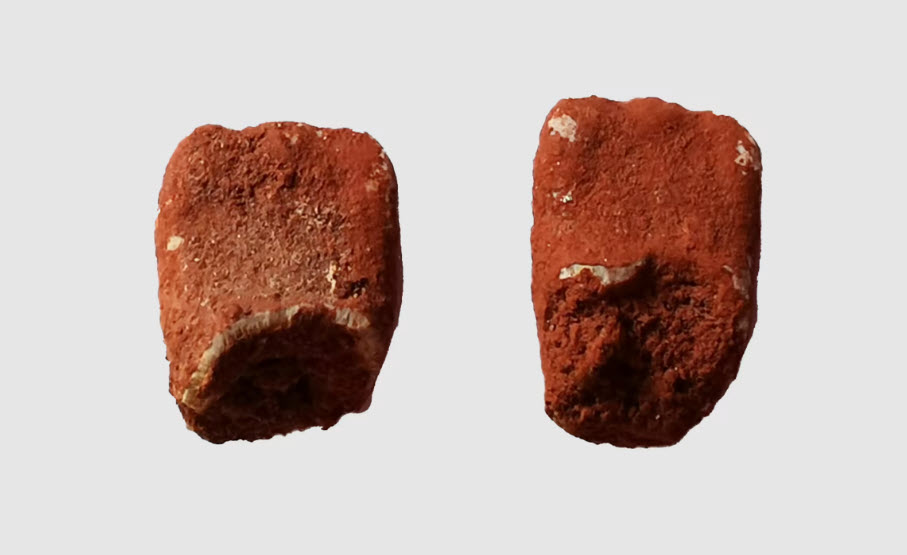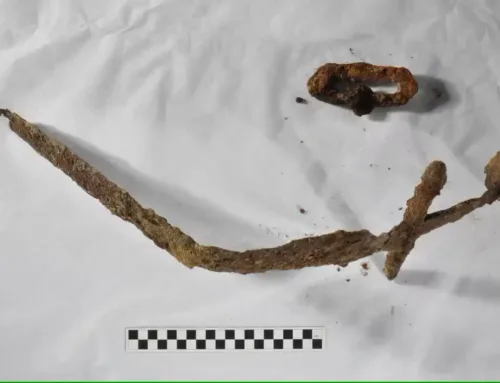A unique Stone Age grave was found in North-Karelia
A unique Stone Age grave was found under a forest road in North Karelia – a dead child was placed on a feather bed with a dog
According to archaeologists, the ancient grave found in the Majoonsu cave in Outokumpu belonged to a small child. Microscopic fragments have allowed a picture to be built up of how the dead were honoured in the Stone Age.
EMILIA SAUKKONEN
4.11.2022

The artist’s vision of what the Majoonsuo child martyr might have looked like in life. Photo by Tom Björklund
The grave was dug near the settlement and painted with red earth. The child’s body was laid to rest on a feather bed. He was given arrows and a dog to rest on his feet.
This may have been the situation when the grave was dug in the Stone Age on the site of the present-day Majoonsuo in Outokumpu.
The University of Helsinki and the National Board of Antiquities have now received the results of research that began in 2018 on what kind of grave was found under a forest road in North Karelia.

The burial site is located about five kilometres from the centre of Outokumpu. Photo by Kristiina Mannermaa / University of Helsinki
The last resting place of a child
The plan was to recover as much soil as possible from the grave and its surroundings. The idea was to use a microscope to see if any of the plant and animal remains that may have been placed in the grave were still there.
A few teeth were found in the Majoonsuo burial site. From their shape, the researchers were able to deduce that the deceased had been a child of about 3-10 years old.
He had taken two cross-edged arrowheads and two other quartz objects with him to the grave. The arrowheads were used to date the tomb to the Mesolithic period.

The arrowheads found in the grave were quartz. Photo by University of Helsinki, Ilari Järvinen / Finnish Heritage Agency, Archaeological collections and Kristiina Mannermaa
Tuija Kirkinen found traces of organic material in the soil samples from the grave. These were found to be hairs, plant fibres and pieces of feather less than a millimetre long.
The feathers could be identified as waterfowl feathers and eagle feathers. They may have come from waterfowl-skinned clothing and arrows found in graves. It is also possible that the grave was lined with feathers.
Tuija Kirkinen estimates that the plant fibres came from rope.
Tuija Kirkinen explains what she found most significant in the research.
Some of the hairs on the deceased’s feet belonged to a dog or a wolf. They may also have come from the child’s clothes.
– But we know that in southern Sweden dogs have sometimes been buried in the same grave as the deceased,” Kirkinen says.
More discoveries may yet come
Finds from Stone Age graves are very rare in Finland, where unburnt bone does not survive in the soil. So far, skeletons from the Stone Age have been found mainly in Åland.
The most significant thing about the Outokumpu grave, according to Dr Tuija Kirkinen, was that the microscopic examinations produced results.
– Of course, we have only examined part of the recovered soil, so there may still be hidden finds in the samples. We have also continued to image and examine the teeth of the deceased.

A few preserved teeth were found in the grave, which helped to determine the age of the deceased. Photo by University of Helsinki, Ilari Järvinen / Finnish Heritage Agency, Archaeological collections and Kristiina Mannermaa
Although the tomb and its finds are of great historical significance, Tuija Kirkinen knows what she has found that sticks in her mind.
– The idea that a child may have been laid on a featherbed is a moving one. It shows how the deceased were honoured and accompanied on their journey back then.
Stone Age finds dating back to the 1960s
1966: first finds from the Majoonsuo site. A private individual found pieces of pottery, quartz flakes and burnt bone.
1992: Archaeologist Petro Pesonen carried out an archaeological inventory and discovered a red-multicoloured lump, damaged in a road construction and interpreted as a grave.
2017: the grave is in danger of being destroyed, so it is better to excavate and study it.
2018: A survey by the National Board of Antiquities uncovered the tomb after only five centimetres of excavation.
source: yle





